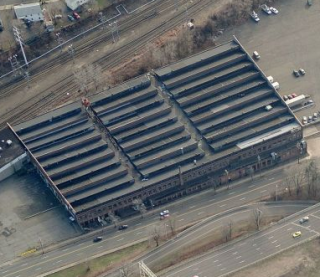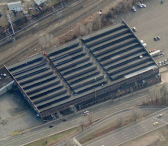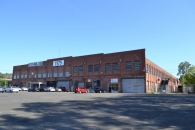Mill Record New Haven
RETURN TO ‘FIND MILLS’Disclaimer: Content for these properties was compiled in 2014-2017 from a variety of sources and is subject to change. Updates are occasionally made under Property Information, however the Connecticut Trust for Historic Preservation (dba Preservation Connecticut) makes no representation or warranty that the information is complete or up-to-date.
- Complex Name (Common)
- Connecticut Co.
- Complex Name (Historic)
-
- Connecticut Co.
- Address or Location
- 1175 State Street, New Haven
- County
- New Haven
- Historic Designation
- Associated Mill Community
- n/a
 What can you do at this mill?
What can you do at this mill?
- Historic Information
Companies Associated w/Complex
- Connecticut Co. ca. 1920-ca. 1948
- New Haven Container Corp. ca. 1950s
- New Haven Electotype, division of the Electrographic Corp. ca. 1950s
- New Haven Paper Box Co. ca. 1950s
Use (Historic)
Largest Documented Workforce
Unknown.
Historic Narrative
Streetcar operations in New Haven effectively began in 1860 with the organization of the Fair Haven and Westville Railroad. Service under this company began with horse-drawn cars on May 6, 1861, and was electrified by the 1890s. While the Fair Haven and Westville Railroad initially served sections of the eastern part of New Haven, numerous additional street railway companies were soon formed to meet the needs of customers throughout the remainder of the city. Included among them at various periods of time were the New Haven and West Haven Horse Railroad, the Winchester Avenue Railroad, the West Shore Railway Company, the New Haven and Centreville Horse Railway, the Whitney Avenue Horse Railroad, the State Street Horse Railroad, and the New Haven Street Railway.
Over the course of the second half of the 19th century, the Fair Haven and Westville Railroad moved aggressively to absorb the numerous other streetcar lines operating in New Haven during the late-19th century. The firm acquired financial control of the last independent competitor operating in the city, the Winchester Avenue Railroad, in 1901, and on May 20, 1904, the latter entity was merged with the parent company. The Fair Haven and Westville Railroad was acquired by the Consolidated Street Railway Company, a subsidiary of the New York, New Haven and Hartford Railroad, just three days later.
In 1907, executives at the New York, New Haven and Hartford Railroad organized a new entity, the Connecticut Company, for the purpose of consolidating the railroad’s extensive network of streetcar lines and the various companies that operated them. The Consolidated Street Railway Company was included in this merger, thus giving the New York, New Haven and Hartford Railroad effective control of all trolley services in New Haven, Bridgeport, Hartford, New London, Stamford, and Waterbury. The only Connecticut cities outside of the Connecticut Company’s network were those in Bristol and Danbury. This system of streetcars continued to operate into the 1920s, however, during the 1920s and 1930s many lines were discontinued and replaced with bus service. The last streetcars to operate in Connecticut ceased operation in New Haven in September 1948.
The Connecticut Company maintained an extensive network of support services for its trolley lines, including car barns, repair facilities, and power stations. These were scattered throughout the city and were upgraded or replaced as needs arose. The trolley barn at the corner of State and James Streets was built ca. 1920 and was used to store the majority of off-duty trolleys in the New Haven system. The Connecticut Company retained the State Street property until streetcar service was ended in 1948. That year it was supplanted by a new bus facility across the street on the west side of James Street, which housed offices, a 350-bus garage, and various repair and body shops. The trolley barn passed to a mix of industrial tenants including the New Haven Electotype division of the Electrographic Corporation, the New Haven Container Corporation, and the New Haven Paper Box Company. The Connecticut Company continued to operate until 1976, whereupon the firm and its transportation network was purchased by the State of Connecticut. Connecticut Transit continued to use the James Street facility until 2010.- Architectural Information
Number of Existing Buildings
Three (3) adjoining primary blocks.
Dates of Construction
ca. 1920, ca. 1965.
Architect
n/a
Builder
n/a
Building Type
Architectural Description
The Connecticut Company’s former State Street streetcar barn is comprised of three primary adjoining blocks located on the south side of State Street, at the southeast corner of State Street’s intersection with James Street. The two original blocks were erected ca. 1920 and are of brick pier construction. The main block is a two-story, 250’ x 450’ red brick trolley barn with full-height window bays topped by corbelled brick headers, rectangular window openings, concrete window sills, tile coping, and a flat roof with 27 sawtooth monitors. The front and rear (west and east) elevations have stepped brick parapets, with only one story of the east (rear) elevation rising above ground level due to the slope of the site. Numerous trolley bays with roll-up doors can be found on both the east and west elevations. Some of these have been retained while others have been infilled or converted into window walls. A continuous course of attic-story windows extends along the roofline of the building’s north elevation facing State Street.
The second original block adjoins the north elevation of the main building and is a one-story, 10’ x 310’ red brick block that originally housed a staff locker room, lunch room, a mechanical room, and boiler house. The building has large rectangular window openings with concrete sills and a flat roof. The last block associated with the plant was erected adjoining the southern end of the east elevation ca. 1965. It is a one-story, 214’ x 68’ concrete block storage building with boarded-up ribbon windows extending along the roofline of the north, east, and south elevations. A pair of loading bays is located at the eastern end of the block’s north elevation and several small windows and pass-through doors are scattered across the remainder of the north elevation. The block has a flat roof.Exterior Material(s)
Structural System(s)
Roof Form
Roof Material
Power Source
Condition
Fair
Condition Notes
The complex is in fair condition. The exterior walls are in need of cleaning and some of the original windows have been replaced or infilled, however, overall, the buildings have been well maintained.
- Property Information
-
Specific Location
One legal parcel (1175 State Street) totaling 5.84 acres located on the south side of State Street, at the southeast corner of State Street’s intersection with James Street.
Adjacent To
Exterior Visible from Public Road?
Yes
Parcel ID / Assessor Record Link
- 171/805/900 / Link →
Acreage
12.79
Use (Present)
- Sources
-
Form Completed By
Lucas Karmazinas
Date
10/08/2015
Bibliography
- List of Connecticut Manufacturers, 1922, 1924, 1930, 1932.
- Directory of Connecticut State Manufacturers, 1936, 1939.
- Industrial Directory of Connecticut, 1947.
- Register of War Production Facilities in Connecticut, 1951.
- Map of New Haven County; Clark, Richard, 1859.
- Atlas of New Haven County, Beers, Ellis & Soule, 1868.
- Aerial Survey of Connecticut, 1934, 1965.
- Sanborn Map Company, 1901, 1911, 1923, 1950.
- New Haven City Directory; Various editions.
- History of the City of New Haven to the Present Time, 1887.
- A Modern History of New Haven and Eastern New Haven County, 1920.
- New Haven Streetcars; Branford Electric Railway Assoc., 2003.
- Western Connecticut Trolleys; Connecticut Motor Coach Museum, 2007.
- Representative View(s)Click on image to view full file







